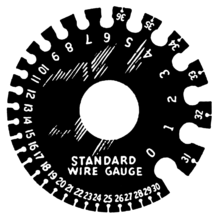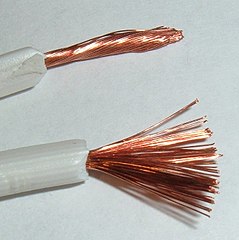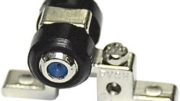As a professional you probably understand wire gauge. You may be able to imagine what a 16 gauge wire looks like, and you know that as the number goes up, the size goes down. Did you ever wonder why that is, and what wire gauge is actually measuring?
Wire gauge is one of those old-school measurements like teaspoons and grains that really should have no place in our super-accurate world. It’s based on measurement systems that go back close to 200 years and the truth is, no one really knows who started measuring wire by gauges.
The one thing that’s for sure, it’s hard to measure round wire with a straight ruler, especially as it gets thicker. On the other hand, it’s hard to measure the circumference of a really thin wire. So it’s a lose-lose proposition, especially if it’s the mid-19th century and you’re 100 years away from inventing the calculator. So what do you do?
You rely on a measuring tool.
Wire gauge is called that because the tool used to measure wire thickness was called… wait for it… a wire gauge.

They looked like this and were found in every mechanic’s and engineer’s tool kit way back when. You may still have one in the garage somewhere. I know I do.
You put the bare wire through the smallest hole in which it will fit and bingo, there’s your measurement. But why do the numbers go up as the sizes go down?
Not real sure of that either but…
The best guess anyone has is that it has to do with early tools used to make wire. Copper wire is made by drawing metal through a die. You can’t just take a 1″ block of copper and pass it through a 1/16″ die, you have to do it in stages. One theory is that wire gauge originally had to do with the number of times the copper had to pass through the drawing machine. Pass it through 10 times, you’ll get a thin wire. Pass it through 20 and it’s thinner still. See?
Another completely made-up guess (gee, it would have been nice if people in the 1800s wrote stuff down) is that there was some sort of sizing wheel and the gauge number has to do with the number of turns of that wheel. No one really knows.
To make matters worse…
Just like everything else before computers, there was one measurement for the U.S. and and one measurement for everywhere else in the world. American Wire Gauge is still the preferred measurement in the US and is often abbreviated AWG. Other places use Imperial Wire Gauge or just plain millimeters.Glad we started measuring everything in the metric system, just like everyone else. Wait, what? Oh well.
Wire Gauge is more standardized now because of two men in the nineteenth century who got fed up with the old wire gauge system. They realized that more accurate measurements were important, so Messrs. Brown and Sharpe took the largest gauge wire, #0, and the smallest gauge wire, #36, and came up with a 40-step system where every step was a fixed amount smaller than the step before. This must have taken a lot of time with no electronic calculators, but we’re glad they did. Their system became the American Wire Gauge measurements and while millimeters would have been nice, it’s better than nothing.
Why does wire gauge matter?
It has to do with resistance. It’s hard to define resistance in a nice easy way, but let’s try. Resistance stops current from flowing. It’s like trying to walk through a swimming pool. The water resists being moved a lot more than air does and it’s harder to get from place to place.
Thicker wire has a lower amount of resistance, and that means that it’s easier for current to flow through it. If the wire is too thin, electricity will not flow through it well, and this can cause heat, low voltage, even complete failure.
For signal flow, it’s a little more complex. RF signals have a tendency to ride along the outside of a wire rather than going all the way through. This is called “the skin effect.” It’s important that there is enough space on the outside of a wire for a high-bandwidth signal like a satellite signal to pass across. Coaxial cables tend to be pretty thick compared to headphone cables for this reason. Typical coaxial cable conductor wire is 18AWG or 18 gauge, while headphone wire can be 30 gauge.
By the way…
Solid Signal doesn’t sell those old-fashioned wire gauges. But, you can find pretty much every kind of wire and cable you’ll need for every job when you shop the great selection at SolidSignal.com.





